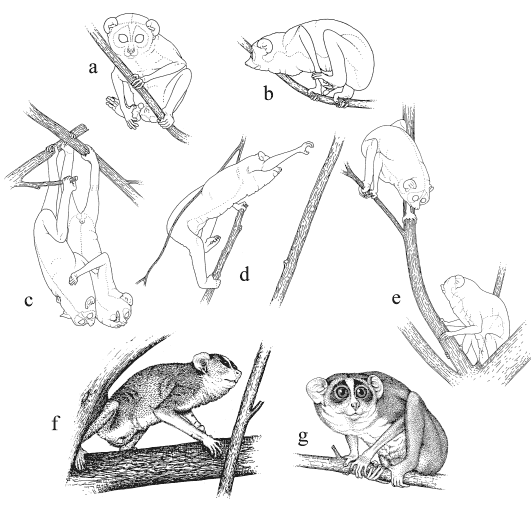

a, b: Urinewashing (urination into the palm of the hand and distribution under the sole of the foot on the same side) is a normal behaviour, probably with the purpose to keep the skin moist for better climbing. An olfactory meaning is also discussed. Excited, nervous animals however, particularly in social stress situations, often show repeated urine-washing as a displacement behaviour. The behaviour is particularly shown by highly excited males during estrous. Aggressive head-down wrestling (c) can be distinguished from similar playwresling by abrupt pushing movements and loud, rhythmic, cricket-like chirping (c). Besides other aggrssive vocalization such as sharp territorial whistling, particularly males may show a noisy locomotor display, running about with abrupt movements, causing repeated, rattling noise with twigs (d). This type of locomotion can be regarded as a severe threat. Staring at a conspecific (e, upper animal), in connection with slow approach or pursuit of the fleeing conspecific, also is a severe threat and may be followed by bite attacks. In cases of severe social stress, frightened inferior animals show a tendency to flee to the lower parts of the cage, trying to hide and to avoid the aggressor. In this situation the animals usually show a crouched posture with the head held deep and a characteristic facial expression, quietly looking towards the aggressor (e, animal below, f, g; see also table with figures of facial expressions. The animal in fig. f shows bite wounds on both forearms caused by attacks). If such a posture is observed, separation of the animals is usually necessary, at least for a limited time, otherwise fighting may escalate and the inferior animal may be badly hurt and killed,
Longterm social stress may occur
without
becoming evident. Fur damage due to overgrooming (see tables with
symptoms
of health problems), a behavioural disturbance, has been observed
within
groups; after separation of the animals this behaviour
disappeared. Lasting
shyness in animals living together with a self-confident and
curious cage
mate may also indicate social stress.
Privacy policy / Datenschutz
|
Loris
and related species: health
|
Last amendment:
5 May 2000
|